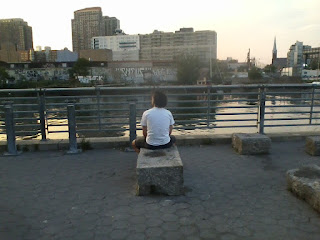Today is Earth Day.
This day was first designated in 1970, a year after the Santa Barbara oil spill. I remember growing up with a great awareness of the environmental movement. Because of that and the Jacques Cousteau television series that aired at the time, for a time I wanted to become a marine ecologist. They also watered, if you'll pardon the metaphor, the seed that had already been planted for my cycling enthusiasm.
I remembered that yesterday, during a late-afternoon ride. I had no particular destination: I zigzagged along Queens and Brooklyn streets, past bridges and brownstones, parks and pre-schools, international neighborhoods and industrial colonies. And this:
It's hard to believe, but this was once the most fertile oyster bed in the world. Lenape natives literally picked them up from the banks and roasted them with the corn, beans and squash they grew nearby. Now a sign admonishes visitors not to eat anything from that water, or even to enter it. Every year for as long as I've been paying attention, the Environmental Agency has rated Newtown Creek, which separates the metal fabricators, cement plants and truck depots of Maspeth, Queens from East Williamsburg, Brooklyn, as one of the most polluted bodies of water in the United States. Sometimes it takes the "top" spot.
Cycling has helped me to appreciate the beauty of landscapes, natural and manmade. It also reminds me of. not only the need to preserve such places, but to use what we've built wisely and resposibly.




















